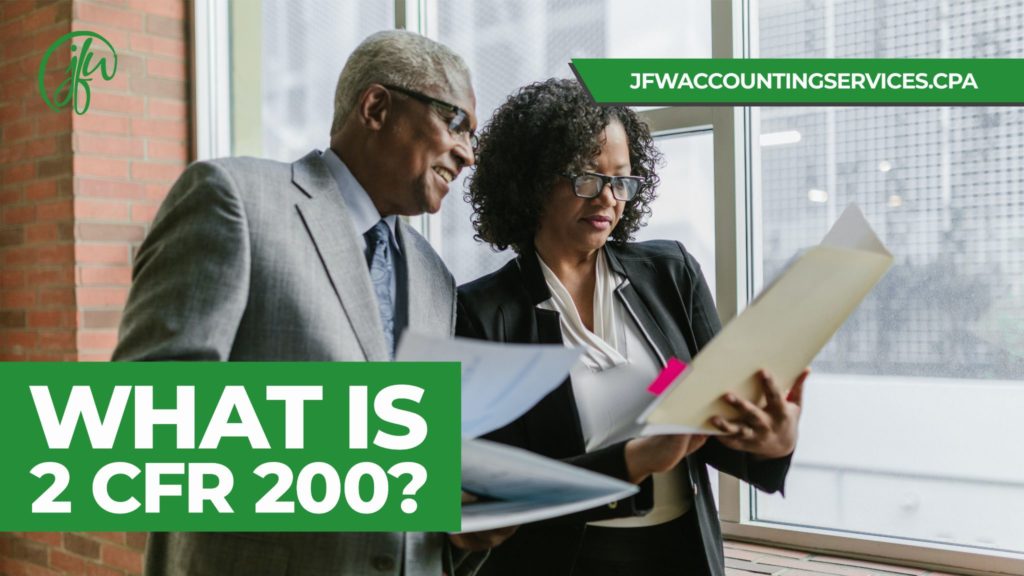Working in the nonprofit industry is an enriching process. However, keeping up with federal regulations and their revisions can be overwhelming. Changes issued by the Office of Management and Budget have raised some questions in nonprofits working with federal awards. This article breaks down 2 CFR 200 and what it means for your organization.
What Did The New Uniform Guidance Say?
In August 2020, the Office of Management and Budget (OMB) issued its final guidance for amendments made to 2 CFR 200, calling it the revised Uniform Guidance. 2 CFR 200 was intended to serve as an official set of rules and regulations for federal grants that created uniform administrative requirements, cost principles, and audit requirements for Federal awards.
The revisions were made in 2020 so that the regulations could be better understood and implemented in nonprofit organizations. The clarifications in the updated Uniform Guidance were set to make it easier for organizations to comply with the conditions of federal awards.
According to the controller of the OMB, “the reform will reduce the total volume of financial management regulations for Federal grants and other assistance by 75%.” The controller went on to emphasize the importance of the new guidance on reforming reimbursements to nonprofits for indirect costs, or expenses required to support the general operations of the nonprofit.
These new regulations benefit nonprofit organizations because they allow the entities to be partially or fully paid for their administrative and management costs, which was previously a gray area in federal awards.
The changes to the Uniform Guidance affect Grantmakers and grant recipients in the following ways:
Federal Grant Administrators
For agencies administering federal awards, 2 CFR 200 must be the reference point for complying with all previous OMB regulations. The new guidance requires administrators to monitor regulations and provide guidance and support throughout the entire life cycle of a grant, not just the awarding phase.
Federal Grant Recipients
One of the most impactful consequences of the OMB revisions, in addition to the changes made to indirect cost reimbursement, is that grant recipients are now required to monitor, regulate, and report on internal controls in their organizations. Recipients that don’t comply with the new requirements may be tasked with special conditions, legal consequences, or a financial audit.
What Does 2 CFR Part 200 Mean For Your Nonprofit?
The revisions to 2 CFR 200 were made so that all parties included in federal awards can have clarification on handling federal awards. However, with so much information passed on by the Office of Management and Budget, nonprofit leaders are still struggling to implement adjustments.
The new Uniform Guidance provides the following assurances:
Nonprofits Can Be Reimbursed For More Direct Costs
The cost allocation rules were changed with 2 CFR part 200. According to the revised OMB Uniform Guidance, more costs can be considered direct costs, which are therefore reimbursable.
In the revision, it states that some program administration costs, like administrative employees assigned to approved projects or programs, can now be recorded on grant progress reports and financial statements as direct costs.
Nonprofits Can Be Reimbursed For Indirect Costs
Even though some costs, like administrative support, that were previously only considered indirect costs are now eligible to be recorded as direct costs, there were additional provisions made to the treatment of traditional indirect costs. One material change now requires pass-thru entities using federal funds, like state and local governments, to reimburse nonprofits for indirect costs.
The reimbursements are based on previous agreements where the nonprofits elected either a 10% reimbursement of total direct costs or a higher rate as negotiated by the federal cost principles.
Uniform Guidance: Key Takeaways
- Indirect costs include expenses not directly connected to a certain project or program within the organization, like salaries, office supplies, and overhead costs that are not directly attributed to the program.
- Federal award administrators will monitor and regulate expenses throughout all phases of the grant life cycle: pre-award, award, and post-award.
- Every nonprofit has the right to negotiate an indirect cost rate with pass-through entities.
- Nonprofits must now, more than ever, update their grant management policies including the tracking of grant expenditures.
- Training regarding implementing 2 CFR 200 is available for nonprofits by state associations of nonprofits and the National Council of Nonprofits
What Can Your Nonprofit Do?
To help smooth the transition of the new regulations set in the OMB Uniform Guidance, there are small steps your nonprofit can take:
- Organize training sessions to discuss the impact of 2 CFR 200 on your nonprofit organization.
- Review previously negotiated federal indirect cost rates and consider renegotiations where applicable.
- Be aware of caps set by federal statutes in your specific grant awards.
- Implement the process of using a grant management checklist so that indirect and direct costs are recorded correctly throughout the entire grant cycle.
Reach out to JFW Accounting Services for clarification on the 2 CFR part 200 and ask how we can help your organization improve its financial health.

Jo-Anne Williams Barnes, is a Certified Public Accountant (CPA) and Chartered Global Management Accountant (CGMA) holding a Master’s of Science in Accounting (MSA) and a Master’s in Business Administration (MBA). Additionally, she holds a Bachelor of Science (BS) in Accounting from the University of Baltimore and is a seasoned accounting professional with several years of experience in the field of managing financial records for non-profits, small, medium, and large businesses. Jo-Anne is a certified Sage Intacct Accounting and Implementation Specialist, a certified QuickBooks ProAdvisor, an AICPA Not-for-Profit Certificate II holder, and Standard for Excellence Licensed Consultant. Additionally, Jo-Anne is a member of American Institute of Certified Public Accountant (AICPA), Maryland Association of Certified Public Accountants (MACPA), and Greater Washington Society of Certified Public Accountants (GWSCPA) where she continues to keep abreast on the latest industry trends and changes.

